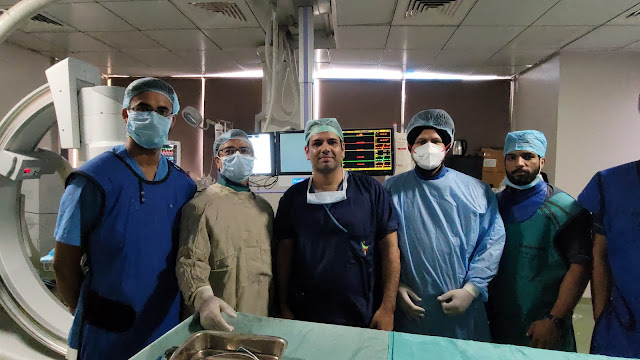Carotid Stenting With and Without Filter
Carotid artery stenting is an endovascular technique that involves placing a stent into the carotid artery lumen to cure stenosis and reduce the risk of stroke. When carotid endarterectomy is deemed too dangerous, it is used to treat the narrowing of the carotid artery in high-risk patients. Traditional treatment for high-grade asymptomatic and symptomatic carotid artery stenosis has been carotid endarterectomy (CEA). Carotid endarterectomy is a procedure that involves exposing the carotid artery and removing plaque from the carotid bulb and proximal internal carotid artery through a neck incision. Minimally invasive procedures have evolved in vascular surgery, as they have in many other surgical disciplines, throughout time. This activity explains carotid artery stenting, including indications, contraindications, and possible problems. Angioplasty and stenting of the carotid arteries may be effective stroke treatments or stroke prevention options. if:-
ü You have a 70% blockage or more in your carotid artery, especially if you've had a stroke or symptoms of a stroke, and you're not in good enough health to undergo surgery — for example if you have serious heart or lung problems or have had radiotherapy for neck cancers.
ü You've had a carotid endarterectomy and are now suffering new narrowing as a result of the procedure (restenosis)
ü Endarterectomy is difficult to do because the narrowing (stenosis) is difficult to reach.
The number of stroke occurrences in the 25 articles considered in this investigation was 326 (2.0%) in protected CAS and 142 (3.4%) in unprotected CAS. After CAS, the use of a cerebral protective device greatly reduced stroke.
Distal cerebral protection devices have been routinely employed to minimise thromboembolic problems during carotid angioplasty and stenting (CAS). However, in patients with twisted carotid arteries, near-occlusion of the carotid artery, or thrombus in the stenotic area, there is a risk of thromboembolic events during the implantation of the protective device. Despite the use of a protective device, some individuals get a stroke after CAS. Although prior studies, including systematic reviews, have shown that the shielded device is effective in minimizing perioperative problems after CAS, several investigations have questioned the device's true value. Recently, two studies were published that disagreed on the efficacy of a protection device. To compare the treatment efficacies of CAS and carotid endarterectomy (CEA), a meta-analysis of treatment outcomes has been updated. Despite the fact that a lot of studies have been published constantly since 2009, there hasn't been a systematic evaluation and meta-analysis of treatment outcomes between protected and unprotected CAS.
DISCUSSION
Despite numerous reports, the effectiveness of a protection device in reducing thromboembolic problems during CAS remains undetermined. The use of a cerebral protective device dramatically reduced the risk of stroke in our study. However, it was not shown to be effective in symptomatic lesions.
Thromboembolic problems can arise during the delivery of the protection device as it passes over severe stenotic lesions or susceptible biofilm. Furthermore, due to the stiffness of the tortuous or kinked carotid artery, the protective device may be unable to be deployed at the destination site. Consequently, despite the fact that protective devices are commonly accepted for the process, the efficacy of protection devices should be examined using current information.
For individuals with symptomatic carotid artery stenosis, carotid artery stenting (CAS) has become an alternate therapy option. The introduction of embolic protection devices has been linked to the improvement in clinical outcomes with CAS. The goal of the trial is to see how flow reversal compares to filter protection during CAS via femoral access.
CONCLUSION
The adoption of a cerebral protective device greatly reduced any symptomatic stroke following the CAS, according to our meta-analysis. However, it was not shown to be effective in symptomatic patients. As a result, before requiring the usage of a protection device during CAS, it should be thoroughly evaluated.
Best doctor for acute stroke. For the Acute Stroke Mechanical Thrombectomy, Dr. Sandeep Sharma is the best radiologist. He is an expert in both suction retrieval and stent retrieval and uses both techniques in exact combination.




Comments
Post a Comment